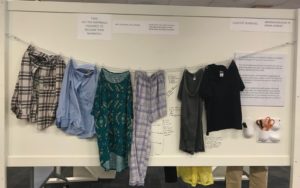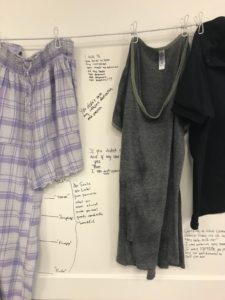Please note that the subject of the following blog post is a humanities project about sexual assault.
Molly Cohen is a graduate of the Department of Theatre Arts at Towson University. With Towson Professor Julie Potter, she worked on What Were You Wearing? Weaving a New Narrative. The installation aims to dismantle the ideology behind the question asked of many sexual assault survivors: “Were you attacked because of how you were dressed?” Molly takes the reader through the process of the installation, from conception to its presence on Towson’s campus and elsewhere.

One year ago, I was sitting in my mentor and former professor Julie Potter’s office talking about how it feels to be a female artist: our responsibility, our struggles, our fears, our voices. She had just seen an article on social media about an exhibit called the What Were You Wearing? Survivor Installation. Originating at the University of Arkansas in 2013, Jen Brockman and Dr. Mary Wyandt-Hierbert were inspired by Mary Simmerling’s poem What I was Wearing. We thought a similar project was needed on our campus, and that we could use our skills as theatre artists to make a greater impact with the power of storytelling.
As a costume designer and historian, Julie cares deeply about the way dress in our culture and society shapes our perception of other people. These perceptions are often too deeply rooted in prejudicial assumptions, ones that create a barrier between us and those we are quick to judge. As a budding costume designer and theatre artist myself, a senior at Towson at the time, I questioned how I could make a difference with my art once I left the university. I am a sexual assault survivor, and the pervasive questions I have received, even with the best of intentions, have left me more pained than I know how to comprehend. The questions, the shame, the internalized guilt… it quickly snowballed my own experience into something much darker and traumatic than I could deal with on my own.
My journey to survivorhood was rife with actions and words as reclamations. Getting dressed is a very ritualist act. What I was able to control and fully choose to clothe myself in, helped me take my power back. Choosing items that made me feel strong, beautiful, truthful to myself… it was a huge part of the journey. Julie and I wanted to shed light on this concept, both the toxic rape myth of clothing equating to sexual assault, and also help survivors reclaim their narratives. Clothing can be a form of healing for, and inform others journey’s towards, surivivorhood, so we wanted to create a space where this could be addressed.

We made a proposal to create this exhibit on our campus with the goal of conducting interviews and creating representations through the clothing of those stories to subvert the dangerous narratives of sexual violence and the male gaze in our society.
I began conducting interviews with sexual assault survivors, starting mainly with former classmates and friends. I knew the question “what were you wearing?” was a required point to address so we could curate the exhibit with these looks. But I wanted to find a way to move past that question to create a productive conversation that offered new ways of talking about this important topic. My goal in working on this project was to offer experiences and tools by which fellow survivors could reclaim their experiences. Because of this, I needed to find a way to make my interviews as healing as I could. My research into interview techniques awarded me insights that will span past this project.
How can the space we create, for ourselves and others, be one of healing? I asked myself this before every interview I sat down to conduct. If I wasn’t in a space to hear and truly take in these deeply nuanced stories, how could I expect their openness and vulnerability in return?
Each interview was so different from the next that I could not go in with a script or rules; I allowed the questions to guide a true dialogue, and my presence allowed the interviewee and myself to share ideas and thoughts with one another, often impactful revelations that would occur at that very moment.
Quickly, my interviews went from talking of the violence we’d experienced, to basking in the strength we each have and the victories – big and small – we achieve each day. I’ve learned so much from each person, and will take their power with me as I move throughout my own journey, as both an artist and a survivor.

The exhibit was set to open in April 2019 Towson Cook Library. We planned it as a multimedia, multi-spaced installation across campus, involving clothing from our Historic Collection, and accounts of sexual violence dating back to the 1800s. We knew we needed help to make this exhibit a reality. Julia Caffery, Web Services Librarian, And Joyce Garczynski, Assistant University Librarian for Development & Communications, were instrumental in the growth and launch of this project.
They helped us gather stories from The Baltimore Sun archives so that we could include accounts of sexual assault that spanned decades, and centuries. We used police records and recordings to highlight the toxic antiquated language. Their feedback, problem-solving, and help throughout this journey helped us gather momentum to expand the programming, including a month of events occurring in conjunction with the installation; these events span various humanities fields and include book talks, staged readings, a zine workshop, and more.
Being awarded the Maryland Humanities grant in December was a truly humbling honor that allowed our exhibit to actualize into something more meaningful than we could have imagined. We were galvanized to take it a step further. We knew the installation was meant for more than the Towson community and needed on as many campuses as possible. MICA partnered with us to install a pop-up version in their own library, and UMBC plans to do the same in the following academic year.
Our desire to add visual impact and artistic meaning to the exhibit manifested in a few different ways. I led the creation of different interactive elements that would live in the exhibit as a form of healing. We strung up a clothesline of donated clothes, complete with scissors, markers, safety pins, with the following instructions:
Use the materials provided to reclaim your narrative.
Rip, cut, draw, pin, express.
Share what you want to share, wear what you want to wear, and tear what you want to tear.
During the exhibit opening, students came by and began writing on the walls. Sharing their stories, their traumas, their reclaiming actions, their pain, their self-love. It was so inspiring to bear witness to; to see that our work was creating an impact, making people stop and thinking, allowing a space for those to share- it was everything we could have hoped for.
Julie and I are so grateful for the support, guidance, and space given to us. The number of people whose minds, hearts, and hands will touch this project continues to grow each day. Students, faculty, staff, and community members alike. We hope our work has offered a space for survivors to share their stories in their own terms and voices, and for allies to gain tools to support, listen, and create spaces for healing.
What Were You Wearing? Weaving a New Narrative closes on April 30. Learn more about the installation on Thursday’s Humanities Connection, which will be available here. Find more information here. Disclaimer: The views and opinions expressed on our blog do not necessarily reflect the views or position of Maryland Humanities or our funders.

